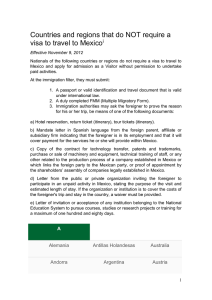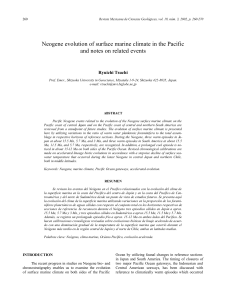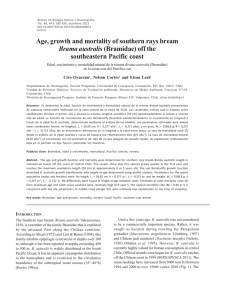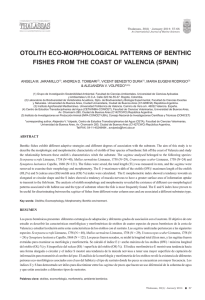Germán Pequeño and Julio Lamilla As far as the distribution of
Anuncio
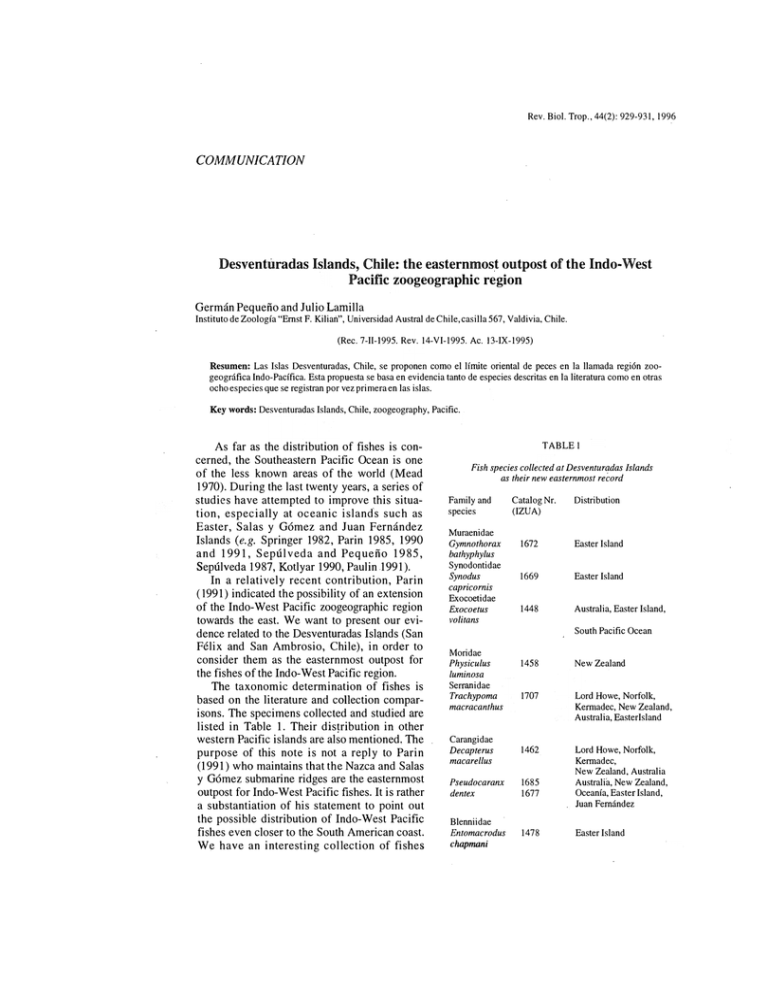
Rev. Biol. Trop., 44(2): 929-931,1996 COMMUNICATION Desventuradas Islands, Chile: the easternmost outpost of the IndomWest Pacifie zoogeographic region Germán Pequeño and Julio Lamilla Instituto de Zoología "Ernst F. Kilian",Universidad Austral de Chile,casilla 567,Valdivia, Chile. CRee. 7-Il-1995. Rev. 14-VI-1995. Ac. !3-IX-1995) Resumen: Las Islas Desventuradas, Chile, se proponen corno el límite oriental de peces en la llamada región zoo­ geográfica Indo-Pacífica. Esta propuesta se basa en evidencia tanto de especies descritas en la literatura como en otras ocho especies que se registran por vez primera en las islas. Key words: Desventuradas Islands,Chile,zoogeography,Pacifico As far as the distribution of fishes is con­ cerned, the Southeastern Pacific Ocean is one of the less known areas of the world (Mead 1970), During the last twenty years, a series of studies have attempted to improve this situa­ tion, especially at oceanic islands such as E aster, Salas y Gómez and Juan Fernández Islands (e.g. Springer 1982, Parin 1985, 1990 and 1991, Sepúlveda and Pequeño 1985, Sepúlveda 1987, Kotlyar 1990, Paulin 1991). In a relatively recent contribution, Parín ( 1991) indicated the possibility of an extension of the Indo-West Pacific zoogeographic region towards the east. We want to present our evi­ den ce related to the Desventuradas Islands (San Félix and San Ambrosio, Chile), in order to consider them as the easternmost outpost for the fishes of the Indo- West Pacific regíon. The taxonomic determination of fishes is based on the literature and coHection compar­ isons. The specimens collected and studied are listed in Table 1. Their distribution in other western Pacific islands are also mentioned. The purpose of this note is not a reply to Parin (1991) who maintains that the Nazca and Salas y Gómez submarine ridges are the easternmost outpost for Indo-West Pacific fishes. It is rather a substantiation of his statement to point out the possible distribution of Indo-West Pacific fishes even closer to the South American coast. We have an interesting collection of fishes TABLE 1 Fish species colla·ted at Desventuradas lslands as their new easternmost record Family and Catalog Nr. species (IZUA) Distribution Muraenidae Gymnothorax 1672 Easter Island 1669 Easter Island 1448 Australia,Easter Island, bathyphylus Synodontidae Synodus capricornis Exocoetidae Exocoetus vo/itans South Pacific Ocean Moridae Physiculus 1458 New Zealand 1707 Lord Howe,Norfolk, luminosa Serranidae Trachypoma Kerrnadec,New Zealand, macracanthus Australia,EasterIsland Carangidae Decapterus 1462 Lord Howe,Norfolk, Kermadec, macarellus New Zealand, Australia Pseudocaral1x 1685 dentex 1677 Australia,New Zealand, Oceanía,Easter Island, Juan Femández Blenniidae Entomacrodus chapmani 1478 Easter Island 930 REVISTA DE BIOLOGlA TROPICAL from Desventuradas Islands, of which several are new records. This fact has changed our con­ cepts and hence the motivation for the proposal af an extension of the Indo- West Pacific zoo­ geographic region. The ímportance of these fishes must be realized because untíl now, they have not been found in coastal South American waters which are closer to Desventuradas than Easter Island or other South Pacific oceanic islands. Thus there ís a good possibility that the oceanographic characteristics of the waters between Desventuradas and the Chilean coast­ line are a barrier to the passage of f ishes between the two zones (Fig. 1). Although sorne r""----���� 18' AGUAS SUBTROPICALES �J lQulauE I 20' 24' . . ISLA SAN FELlX ISLA SAN AMBROSIO 28' 30' 32' VALPARAISO AGUAS SUBANTARTICAS � ';'"-'&'--7;;0;:-'_.... ' -.d---: B�O':"" ' --'---:!:S7 ::- ' --'---:!;76::-' -.,.4..-':;'74�,--LL--:7 2 BL 2:- 4 3 ' 36' Fig. 1, Geographic allocation of Desventuradas lslands (San Félix and San Ambrosio), with surface salinity and temperature isoclines for Southern Hemisphere summer and winter (From Robles.ln:Bahamonde 1987). PEQUEÑO & LAMILLA: Outpost of the Indo-West Pacific other species occurring in the Desventuradas Islands are also found along the coast off South America, i ..e. Polyprion oxygeneios (Bloch and Schneider 1801) ( Percichthyidae), Caprodon long imanus ( Günther 1859) (Serranidae), Chei­ lodactylus gayi (Kner 186 5) ( Cheilodactyli­ dae), Gymnothorax porphyreus ( Guichenot 1 848) (Muraenidae) ; they seem to be the exception, because an important portian of the ichthyofauna of Desventuradas is also com­ mon to Juan Fernández Islands, l ike Muraen ichthys chilensis Mc Cos ker 1979, Lote lla fernan d eziana Rendahl 1921, Monocentris reedi Schultz 1956, Girella feli­ ciana Clark 1938, Umbrina reedi (Günther 1880), Chiron emus b icorn is (Steindachner 1898) and Pseudolabrus gayi (Valenciennes 1839). Moreover, other species such as Pseudocaran x dentex (Valenciennes 1833), Pteryg otrig la picta ( G ünther 1880) and Exocoetus volitans Linnaeus 1758, are widely distributed in Oceanía. Thus, looking at the g e neral taxonomic composition of the Desventuradas Isl a n ds , the similarity to Western Pacific islands is evidently much stronger than the weak similarity to the South American proper ichthyofauna. 93 1 REFERENCES Bahamonde, N. 1987. San Félix and San Ambrosio, las islas llamadas Desventuradas, p. 85- 1 0 0. In: J.C. Castilla (ed.). Las islas oceánicas chilenas: conocimien­ to científico y nec esidades de inve s t i g a c i ó n. Universidad Católica de Chile, Santiago. Kotlyar, A.N. 1990. Dogfish sharks of the genus Etmopterus Rafinesque from the Nazca and Sala y Gomez ridges. Trudy Inst. Okeano!. 125: 127-147 (in Russian). Mead, G.W. 1970. A history of South Pacific fishes, p. 236-251. In W.S. Wooster (ed.). Scientific Exploration of the South Pacifico National Academy of Sciences, Washington, D.e. P a r i n , N. V. 1985. T h r e e new species of t h e g e n u s Physiculus and other fishes (Moridae. Gadiformes) from submarine seamounts of the Eastern South Pacific Ocean. J. of Ichthyol. 24: 46-60. Pafin, N.V. 1990. Preliminary review of the fish fauna 01' the Nazca and Sala y Gomez submarine ridges (South East Pacific Ocean). Trudy Inst. Okeanol. 125: 6-36 (in Russian). Pafin, N..V. 1991. Fish fauna of the Nazca and Sala y Gomez submarine ridges, the easternmost outpost of the Indo-West zoogeographic region. Bul!. Mar. Sci. 49: 67 1-683. Paulin, C.D. 199 1. T w o new species o f t h e g e n u s Physiculus (Moridae), from seamounts o f the southeast­ ern part of the Pacific Ocean. J. Ichthyol. 3 1: 1-5. ACKNOWLE DGEMENTS Sepúlveda, J.!. 1987. Peces de las islas oceánicas chile­ nas, p. We thank Alex Wilder ("Chris" Fishery Enterprise, Valparaíso) and Comité Oceanográ­ fico Nacional (CONA) for the facilities to obtain comparative material from Easter Island. Chris Paulin, Pe ter McMillan and Clive Roberts (National Museum of New Zealand, Wellington) for allowing fish collection analysis; Fundación Andes (Santiago, Chile) provided G.P with sup­ port for a visit to Wellington; Francisco J. Neira made important comments and revíewed the English. This research was funded by Project S93-41 of the Universidad Austral de Chile. 225-245. In J..C. Castilla (Ed.), Las islas oceánicas chilenas: conocimiento científico y necesi­ dades de investigación. U niversidad Católica de Chile, Santiago. Sepúlveda, .l.!. & G. Pequeño. 1985. Fauna íctica del Archipiélago de Juan Fernández, p. 8 1-9 1. In P. Arana (ed.). Ar c h i piéla g o Inves t i g a c ion es de Juan Marinas Fernández. en el Editorial Universitaria, Santiago. Springer, V.G. 1982. Pacific plate biogeography, with spe­ cial reference to shofefishes. Smith. Contr. Zool. 367: 4- 182.


